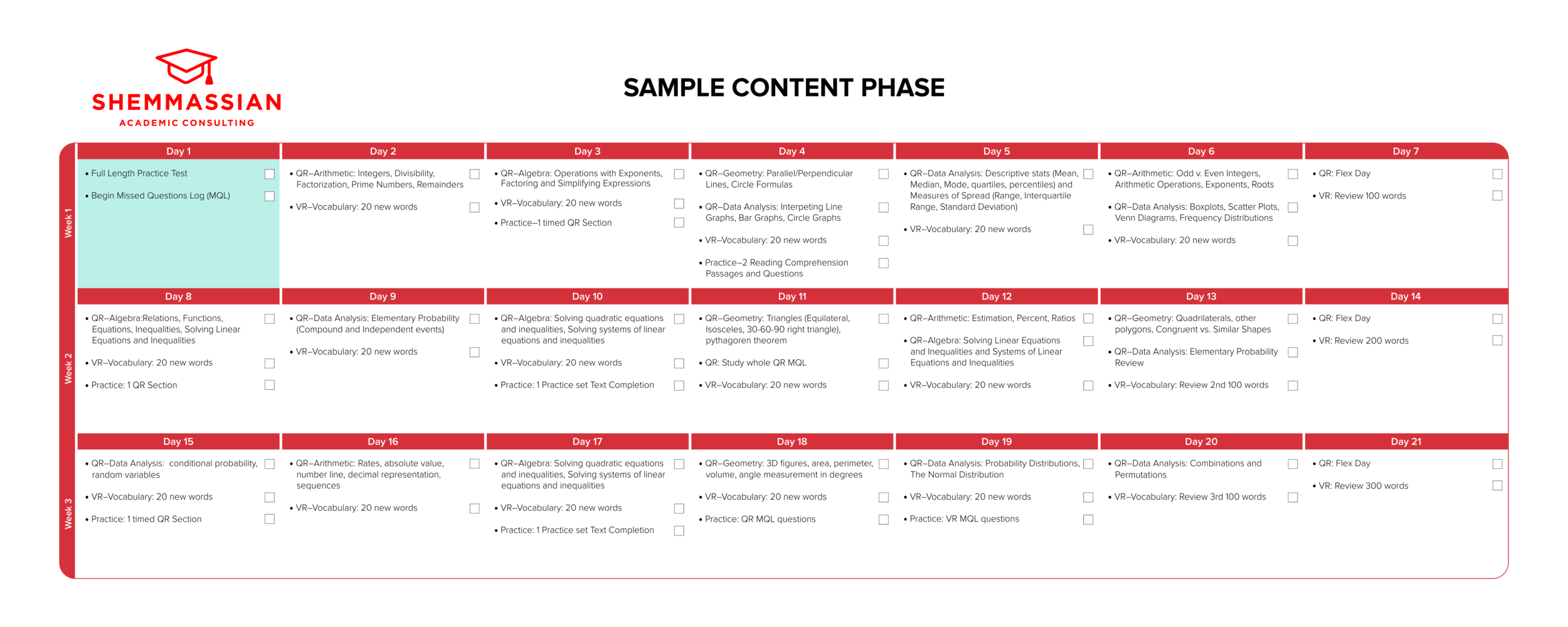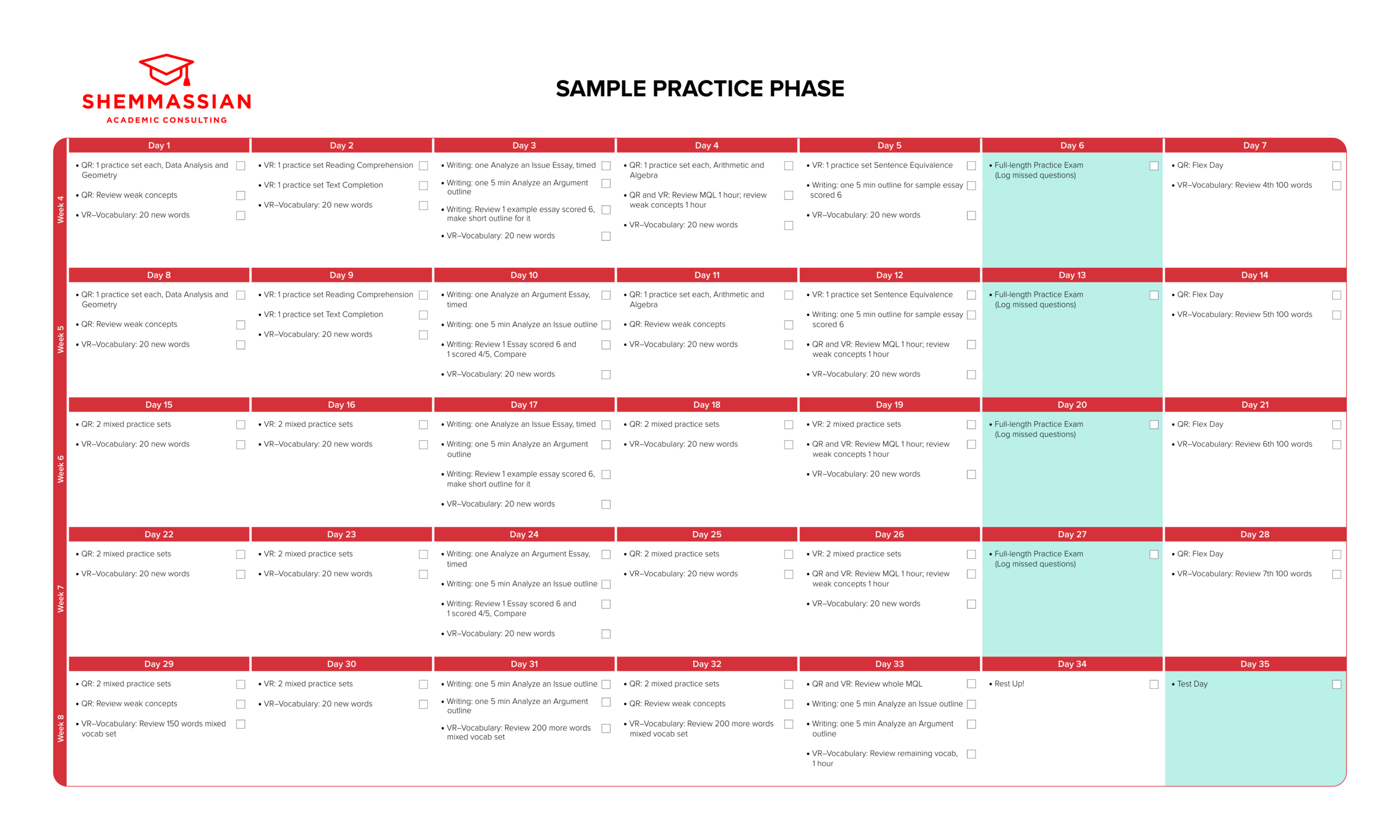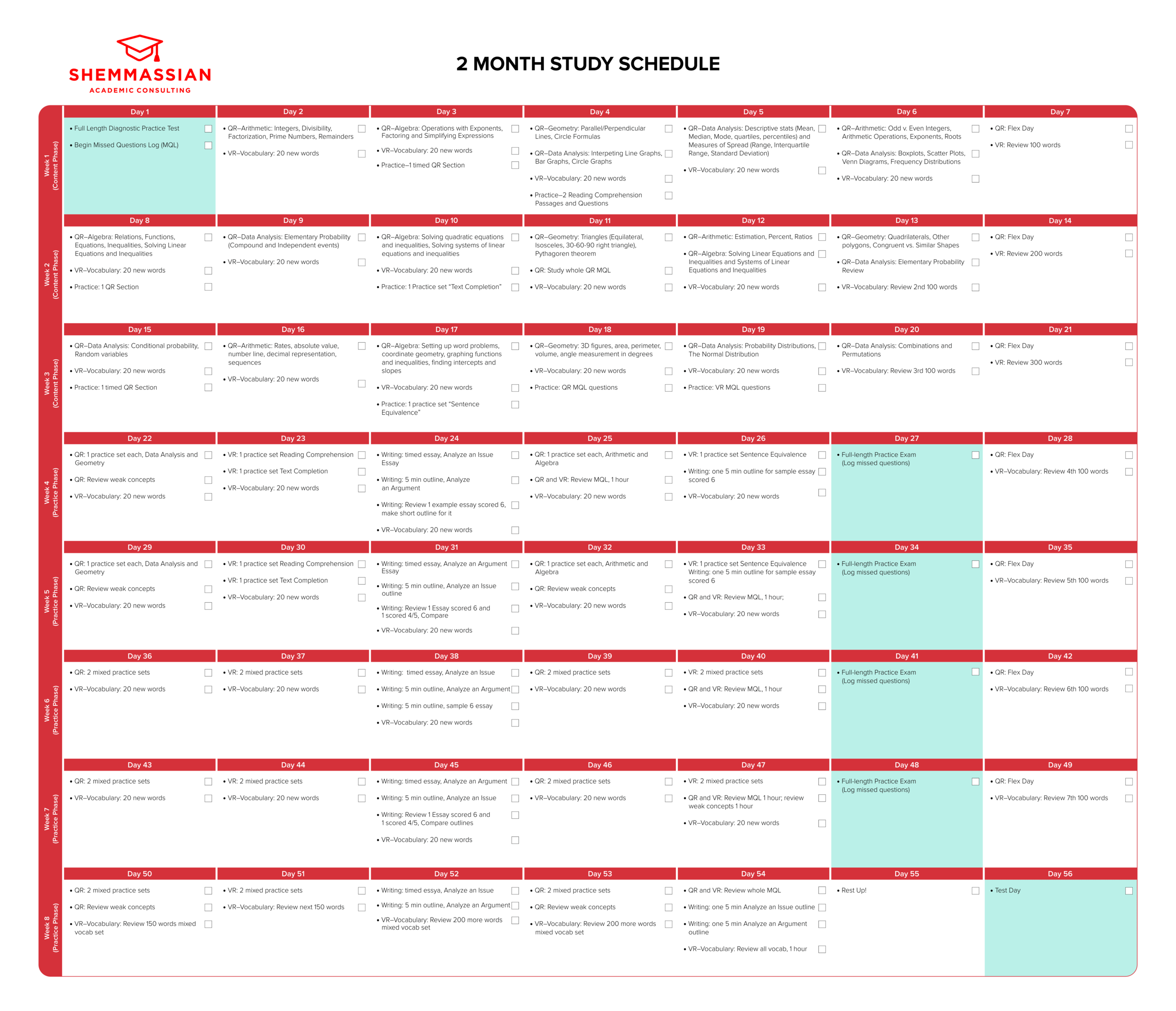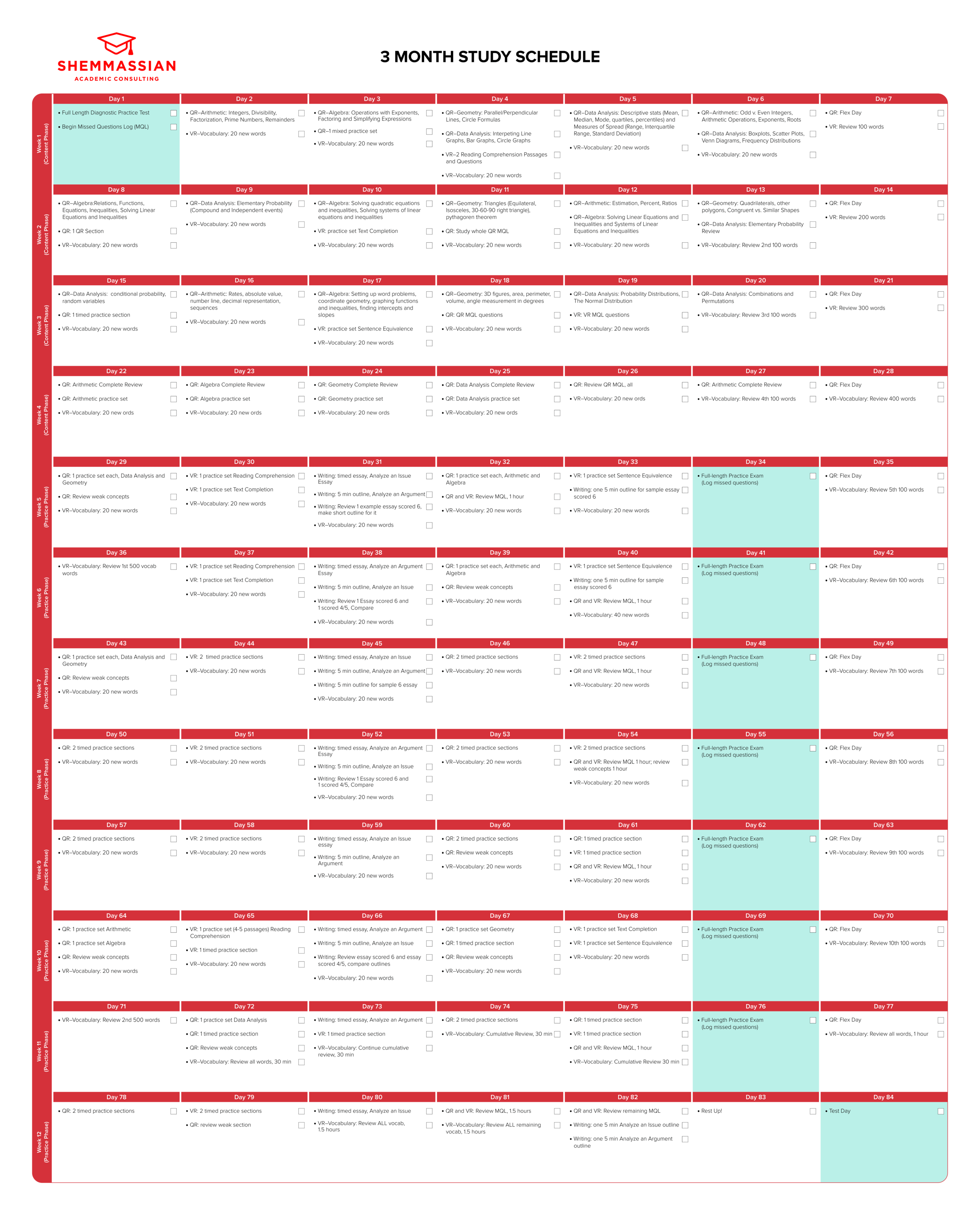The Ideal GRE Study Schedule (2 Weeks | 1 Month | 2 Months | 3 Months)
/Learn how to study effectively for the GRE with detailed schedules for 2 weeks, 1 month, 2 months, or 3 months to maximize your score.
-----
Introduction to building a great GRE study schedule
There are dozens of graduate degrees to choose from and applying to each one is different. But amidst the tangle of different deadlines and application requirements, there is one thing you can count on to be relatively constant: the GRE.
The GRE isn’t required by all programs, and the extent to which programs prioritize scores certainly does vary. What the GRE does, however, is give you a lot of flexibility and help make up for what you might consider weak spots in your application. Whatever your plans may be, a great GRE score puts you in a very good place.
Flexibility comes from the fact that the GRE is required by many graduate programs, and accepted by almost all. Even some of the nation’s top Law Schools and Business Schools accept the GRE in lieu of the LSAT or GMAT. And despite what you may hear, most admission councils don’t actually favor either of the specialized tests over the GRE.
Maybe you’re unsure about the specific graduate degree you want to pursue. Suppose you’re torn between an MBA and an MS in Data Science, for example. Rather than studying for months and spending hundreds of dollars for each exam, you can save time and money by focusing on the GRE. The same applies to any student torn between an MA/MS, PhD, JD, MPP, and others.
Perhaps most importantly, the GRE is the most immediate thing you can do to help your chances in graduate admissions. An undergraduate GPA takes years to form, and by the time you’re an upperclassman, it’s hard to change it significantly. Work and research experience, as well as relationships with potential recommenders, also take months or years to develop.
The GRE, on the other hand, is offered almost every single day. You could ace it next week and immediately improve your admission chances.
To ace the GRE, though, you’ll need to make a schedule. Having a strict GRE study plan is the key to scoring well on the exam. Your study plan will be your guide and accountability tracker. Students who make thoughtful and realistic study schedules routinely achieve better scores on the GRE.
And that’s why you’re here–to create your GRE study plan, lay the groundwork to achieve (and surpass!) your target scores, and ultimately gain admission to your choice of grad school. Let’s get started!
What this GRE Study Schedule Guide Covers:
This guide is meant to give you a framework for writing a GRE study plan tailored to your own specific needs–one that is comprehensive, adaptable, and, of course, effective.
Below, the guide covers:
Detailed steps to building the best study plan for you, including how to choose a test date and how to organize each week until your exam
Answers to the most frequently asked questions about the GRE study schedule
Template study schedules for 2-week, 1-month, 2-month, and 3-month GRE study plans
The guide does not assume any specific study materials, only that you do have access to full-length practice tests as well as more targeted review content. A good place to start is the free preparation material provided by ETS, the company that writes the GRE. Freely available to everyone who registers for the GRE are two full-length online practice tests, overviews of each of the three sections, as well as reviews of the content on each section.
-----
Part 1: How to build a GRE study schedule tailored to your needs
Step 1: Select a GRE test date and allocate daily study time
The first thing you want to do is pick a date. Picking a test date is important practically and emotionally: First, it sets a constraint on your study time and helps determine your study strategy. Second, by making the prospect of taking the exam reality, you may feel a bit more motivated to start studying!
But you shouldn’t randomly book a test date and hope to simply capitalize on the post-registration motivation. There are several factors you should consider when choosing. Here are some questions to ask yourself:
When do I want to apply to graduate programs? At the very least you want to have your scores before you send off applications. Official score reports are returned 10-15 days after your test date, so leave at least two weeks between your test and application deadline. On the other extreme, your GRE scores remain official for 5 years, so don’t bother taking the GRE if you don’t plan on applying to a graduate program in that time.
What time commitments do you have during the time before you plan to apply to graduate programs? Studying for the GRE takes time, and it’s easier and more efficient to study for it when you have fewer obligations. This might take some foresight. Some college students might take the GRE as early as the summer after their freshman or sophomore year if they think they’ll have internships the next couple of summers and want to apply to graduate programs during their senior year.
What are your target scores? Maybe this question is surprising. Why not aim for a perfect 6.0 Writing, 170 Verbal, and 170 Quantitative Reasoning, you ask? The work it takes to achieve those scores might not be the best course for you. A great GRE score is a few points higher than the average scores of students admitted to your desired graduate program. Most programs will have the percentiles of admitted students’ scores readily available on their websites, and we highly encourage you to make a data-driven decision.
How much additional work do you need in order to reach those scores? Suppose you take a practice exam (like ETS’s POWERPREP® Online) and score ten points higher than both the average Verbal and Quant scores of your dream program. If this is the case, you probably don’t need to study as much as if your scores were ten points lower on each.
Take this last tip with a BIG grain of salt, though. No matter how well you score on a diagnostic practice test, you should still aim to study for at least a month for the GRE. Your diagnostic score may not be representative; do not assume you’ll be able to recreate it with ease under real test conditions on test day, especially if it is a higher score.
Finally, after you decide on a test date, try to budget a few hours every day until then. Remember to consider time in class or doing schoolwork, work hours, holidays, and even desired personal time when creating your GRE study plan, regardless of the study plan length you decide upon. The remaining waking time should be used for GRE studying.
On a given day of studying, you should devote at least an hour and a half to GRE studying. If your math gives you a number smaller than this, you should revisit your test date. The most efficient daily study sessions range from 2 to 4 hours per day.
Step 2: Design the content phase of studying
Now that we’ve allocated our daily study time, we can begin to fill out our study plan. You’ll split your schedule into two distinct parts, the first of which will be the Content Phase.
In this section, you’ll spend 70% of your time on the material you are expected to know for the GRE and 30% on practice problems. Since the GRE is a general aptitude test, rather than a subject-specific test, this phase should usually comprise less than half of your total study schedule.
However, there is a concrete set of material covered on the GRE, and it’s very possible and necessary to study that material. Specifically, if you know you are not comfortable with the math covered on the GRE or if you often encounter words you don’t know when you read a newspaper, you may want to allocate more time to your Content Phase of studying.
Here’s how to organize this material in your schedule:
Assign a little less than half of your time as the Content Phase of studying. If you decide to take the GRE in two months (after considering the questions in the last section!), give yourself 3 weeks to focus on content.
In preparation for the Quantitative Reasoning section, make a list of all concepts covered on the exam. A complete list can be found on the ETS website. There are 4 main fields of math covered on the GRE–Arithmetic, Algebra, Geometry, and Data Science–and each one encompasses about 10 to 15 core concepts.
Now, you have about 60 individual concepts to master in three weeks. As such, you should aim to cover 20 of these concepts every week. If you decide on a schedule longer or shorter than 2 months in total, you’ll have to cover fewer or more concepts per week.
(Wait a second–60 units of math?! Don’t panic–most of these concepts are actually very short, and some are even just a single definition. You’ll move through them faster than you may expect.)
The geometry on the GRE includes characteristics of parallel and perpendicular lines and of circles and basic regular polygon. The GRE does not require any geometric proofs.)
In preparation for the Verbal Reasoning section, you’ll have to learn advanced vocabulary that, frankly, you probably wouldn’t encounter in day-to-day life. Instead, look to one of many flashcard options. You can supplement your vocab work by reading high-level writing, keeping a log of unfamiliar words, and studying their definitions.
With the Verbal and Quantitative Reasoning in mind, here is an example of a 3-week Content Phase completely mapped out:
sample content phase of gre study schedule
Here are some things to note about this sample content structure:
This study schedule covers the four categories of Quantitative content in parallel rather than sequentially. This way, you won’t find at the end of this phase that you forgot all the math you began with!
Every weekday introduces 20 new words. The next day you review all the week’s words, then all words cumulatively. Try to review vocab constantly.
This schedule requires only 1-3 hours per day, allowing you to maintain other commitments during your study time.
The end of each week includes flex time you can use to revisit material you didn’t finish, to review material you need a little extra work on, or to just rest and make sure you’re ready for the next week.
Notice the checkboxes next to each task. This schedule can double as an accountability measure–we highly recommend building this into your own GRE study plan!
This content phase assumes the student needs significant time to review or relearn all these math topics. Some students don’t need the same math review, and for this reason, they might have a content phase much more centered on vocabulary or just a much shorter content phase in total. The initial practice test is essential for helping to identify your own needs.
Step 3: Design practice phase of studying
Last comes the Practice Phase of your studying. This phase is the inverse of the previous one: now you’ll spend 70% of your time on practice questions and 30% on vocab and math review.
The practice phase is longer than the content phase because, on the GRE, it’s much more important that you be comfortable answering questions on a time limit than it is that you know every detail about every topic.
Practice is essential for learning the GRE question types, which in some ways are content in and of themselves. This is especially true for the Verbal Reasoning section: Reading Comprehension, Text Completion, and Sentence Equivalence each present unique challenges.
The Quantitative Comparison, Select One, Select Multiple, and Numeric Entry questions may have their own strategies, but they ultimately cover the same math.
Needless to say, practice is essential for refining your strategies on the Analytical Writing Section as well.
Here is how a student equally focused on QR, VR and Writing might organize their practice phase:
sample practice phase of gre study schedule
Here are some things to note about this practice phase schedule:
Every week you take a practice test, followed by a flex day. Your only task on flex days is to review vocab; use these more relaxed days for flex studying or to recharge for the next week.
You see a lot of “MQL” on here, and this stands for the Missed Questions Log. The MQL is a centralized place where you’ll track and review the concepts you’re missing on your practice problems. It’s really important that you learn from your mistakes and spend a lot of time reviewing questions you originally got incorrect.
This schedule should only take 2-3 hours of studying per day, on average.
In the final week, remember to review the topics you feel confident about, too. Chances are, you didn’t miss as many questions on those topics, so there’s been less reason to revisit them until now.
Even for individual sections, try to practice under real test conditions. This means timed and with a calculator on your computer screen.
Step 4: Refine your GRE study schedule:
Finally, keep an open mind after you’ve made the first draft of your GRE study plan. Many students are reluctant to change their schedule, fearing that a change of plan results from some sort of lack of discipline or accountability. This isn’t true! You know yourself and your needs; if something isn’t working, change it.
Not only will you realize your original time allotments for each topic aren’t perfect, but you’ll also run into everyday obstacles like unexpected school, work, or family obligations.
The trick is to build flexibility into your schedule from the beginning. With flex days on the weekend or adaptive sessions like your Missed Question Log reviews, you’ll maximize efficiency and keep your studying topical and fun. And if even more changes are needed, don’t be afraid to mark up your original schedule.
Good luck making your GRE study plan, and we sincerely hope that this guide will help you score well on this exam!
-----
Part 2: GRE Study Schedule Templates (2 Weeks | 1 Month | 2 Months | 3 Months)
-----
2-week GRE study schedule
If you’re taking the GRE in less than one month, then it’s time to get studying. Yes, it’s recommended that you don’t wait until this close to test day to start studying, but we know it happens. And even if you have as few as two weeks until test day, there’s a lot of progress you can make.
In this very short time frame, you’ll notice that the content phase of studying practically disappears from the schedule. There will be time to review areas with which you are especially unfamiliar, but for the most part, you’ll be learning from practice and your missed question logs (MQL). By focusing on the 2 full-length practice tests and additional practice sections, you’ll learn only what you absolutely need to know in the most efficient way possible.
With this plan, you’ll also be exposed to 500 new vocab words.
If you want to see meaningful progress in only a couple of weeks, you should dedicate at least 3-4 hours per day to studying.
GRE 2-week study schedule
-----
1-month GRE study schedule
You’ll be in a decent place if you give yourself 1 month to study for the GRE. However, it’s not quite as much time as it sounds, so this study schedule requires about 3 hours every day, as well as one day a week you can dedicate to taking a full-length practice GRE exam.
In this study schedule, you’ll spend a week and a half focusing on the GRE math content, after which you’ll dive right into the practice phase of studying, completing, and reviewing two practice sections per day on average.
With this schedule, you’ll be exposed to more than 500 vocab words and will have ample time to gain comfort with all of them.
1-month gre study schedule
-----
2-month GRE study schedule
After 2 months of studying, you’ll have the confidence and familiarity with the GRE material to ace it, come test day. Unlike the shorter timelines, the 2-month GRE study plan allows you time to look at each and every topic in the Quantitative Reasoning sections on the GRE so that nothing will surprise you on the exam itself.
This study schedule includes a 3-week content phase of studying and a 5-week practice phase, and it will take an average of 2-3 hours per day to follow.
This schedule also exposes you to 700 vocab words at a very manageable pace. This will allow you to master the majority of the words recognized as most likely to show up on the GRE.
2-month gre study schedule
-----
3-month GRE study schedule
You’ll be the most prepared person in your testing center after 3 months of diligent study. In 12 weeks, you’ll be able to master every math concept covered on the QR section of the GRE and will become very comfortable with the three question types on the VR section of the GRE. You’ll also cover all 1,000 GRE words that most GRE vocab flashcard packs include and will have time to add your own words from supplemental readings.
This extended timeline also reduces the daily study load to about 2 hours per day. But make sure you stay disciplined–one of the challenges you may face with this study schedule is burnout! On this schedule you may feel more justified in using your flex days for rest if that means you will be able to maintain your study pace afterward.
3-month gre study schedule







